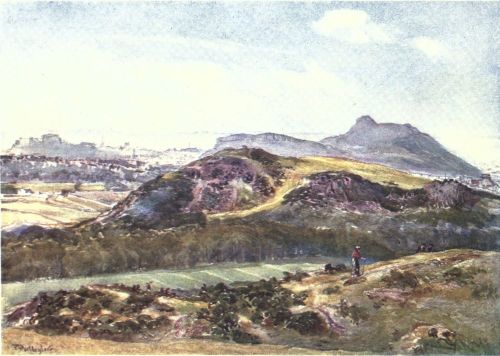Annotation:Arthur's Seat (1): Difference between revisions
No edit summary |
No edit summary |
||
| (7 intermediate revisions by 2 users not shown) | |||
| Line 1: | Line 1: | ||
---------- | |||
{{TuneAnnotation | |||
|f_tune_annotation_title= https://tunearch.org/wiki/Annotation:Arthur's_Seat_(1) > | |||
|f_annotation='''ARTHUR('S) SEAT [1]'''. AKA and see "[[Fly By Night (1)]]," "[[Star Hornpipe (2) (The)]]." Scottish, Hornpipe (2/4 time). B Flat Major. Standard tuning (fiddle). AABB (Hardie): AA'BB (Brody). | |||
---- | [[File:ArthursSeat.jpg|500px|thumb|right|Arthur's Seat from the Braid Hills, c. 1904 by John Fulleylove. To the left are part of Edinburgh, the mass of the Castle, and the shores of Fife. The Salisbury Crags and “Lion” of Arthur’s Seat are above all.]] | ||
The hornpipe was composed by the famous Scots composer and fiddler [[biography:J. Scott Skinner]], appearing first in his '''Cairngorm Series''' (Pt. 6). Arthur' Seat [https://en.wikipedia.org/wiki/Arthur%27s_Seat] is a prominent Edinburgh landmark, a high volcanic plug. The name is quite ancient, having been first recorded by Giraldus Cambrensis in the 12th century as ''Cathedra Arturi'' (the Greek word ''cathedra'' means throne), and stems from the time the area was Brittonic, prior to the invasions of the Anglo-Saxon tribes. | |||
---- | |||
<br> | <br> | ||
<br> | <br> | ||
Bill Hardie notes that the cross bowing he indicates in his printed version of the tune "is particularly suited to the chromatic writing in the second strain." Skinner himself made a 78 RPM recording of the tune in the early 1920’s as part of “The Celebrated Hornpipes” medley. Skinner had also recorded "Arthur's Seat" in 1910 in London with pianist Ethel Stuart, one of a series of Skinner recordings from that session heard by a young Donegal fiddler John Doherty, and added to his own repertory <ref>Thomas Caldwell, "Did you hear about the poor old travelling fiddler?’ - The Life and Music of John Doherty", Doctoral Thesis, 2013, pp. 90-91.</ref>. See also Irish versions under the title "[[Fly By Night (1)]]." | |||
Bill Hardie notes that the cross bowing he indicates in his printed version of the tune "is particularly suited to the chromatic writing in the second strain." Skinner himself made a 78 RPM recording of the tune in the early 1920’s as part of “The Celebrated Hornpipes” medley. See also Irish versions under the title "[[Fly By Night (1)]]." | |f_source_for_notated_version=Jean Carignan (Montreal, Canada) [Brody]. | ||
|f_printed_sources=Brody ('''Fiddler’s Fakebook'''), 1983; p. 26. Hardie ('''Caledonian Companion'''), 1986; p. 39. Skinner ('''Cairngorm Series No. 6'''), 1922. | |||
|f_recorded_sources=Flying Fish FF 70572, Frank Ferrel – “Yankee Dreams: Wicked Good Fiddling from New England” (1991). | |||
Folkways FG3531, Jean Carignan – "Old Time Fiddle Tunes" (first tune of 'Bank'). | Folkways FG3531, Jean Carignan – "Old Time Fiddle Tunes" (first tune of 'Bank'). | ||
Great Meadow Music GMM 2002, Rodney Miller & David Surette – “New Leaf” (2000). | Great Meadow Music GMM 2002, Rodney Miller & David Surette – “New Leaf” (2000). | ||
Philo 2001, "Jean Carignan" (first tune of 'Banks Medley'). | Philo 2001, "Jean Carignan" (first tune of 'Banks Medley'). | ||
Topic 12T280, J. Scott Skinner "The Strathspey King." | Topic 12T280, J. Scott Skinner "The Strathspey King." | ||
|f_see_also_listing= | |||
}} | |||
---- | ------------- | ||
Latest revision as of 19:47, 24 November 2023
X:1 T:Arthur Seat [1] C:J. Scott Skinner M:4/4 L:1/8 K:Bb f/|b/>f/d/>B/ A/>B/ F/>E/|D/D4/4D/ F/>B/ d/>f/b/>f/|=e/>f/ _e/>f/ d/>f/c/>f/| b/>f/d/>B/ A/>B/ F/>E/|D/D4/4D/ F/>B/ d/>f/b/>f/|=e/>f/g/>f/ _e/>c/A/>f/|B{a}bB:| |:^f/|g/>^f/g/>d/ e/>d/e/>c/|f/>=e/f/>^c/ d/>c/d/>B/|e/>d/e/>=B/ c/>B/c/>_B/|A/>c/f/>=e/ f/>^f/g/>a/| b/>f/d/>B/ A/>B/ F/>E/|D/D4/4D/ F/>B/ d/>f/b/>f/|=e/>f/g/>f/ _e/>c/A/>f/|B{a}bB3:|
ARTHUR('S) SEAT [1]. AKA and see "Fly By Night (1)," "Star Hornpipe (2) (The)." Scottish, Hornpipe (2/4 time). B Flat Major. Standard tuning (fiddle). AABB (Hardie): AA'BB (Brody).

The hornpipe was composed by the famous Scots composer and fiddler biography:J. Scott Skinner, appearing first in his Cairngorm Series (Pt. 6). Arthur' Seat [1] is a prominent Edinburgh landmark, a high volcanic plug. The name is quite ancient, having been first recorded by Giraldus Cambrensis in the 12th century as Cathedra Arturi (the Greek word cathedra means throne), and stems from the time the area was Brittonic, prior to the invasions of the Anglo-Saxon tribes.
Bill Hardie notes that the cross bowing he indicates in his printed version of the tune "is particularly suited to the chromatic writing in the second strain." Skinner himself made a 78 RPM recording of the tune in the early 1920’s as part of “The Celebrated Hornpipes” medley. Skinner had also recorded "Arthur's Seat" in 1910 in London with pianist Ethel Stuart, one of a series of Skinner recordings from that session heard by a young Donegal fiddler John Doherty, and added to his own repertory [1]. See also Irish versions under the title "Fly By Night (1)."
- ↑ Thomas Caldwell, "Did you hear about the poor old travelling fiddler?’ - The Life and Music of John Doherty", Doctoral Thesis, 2013, pp. 90-91.

